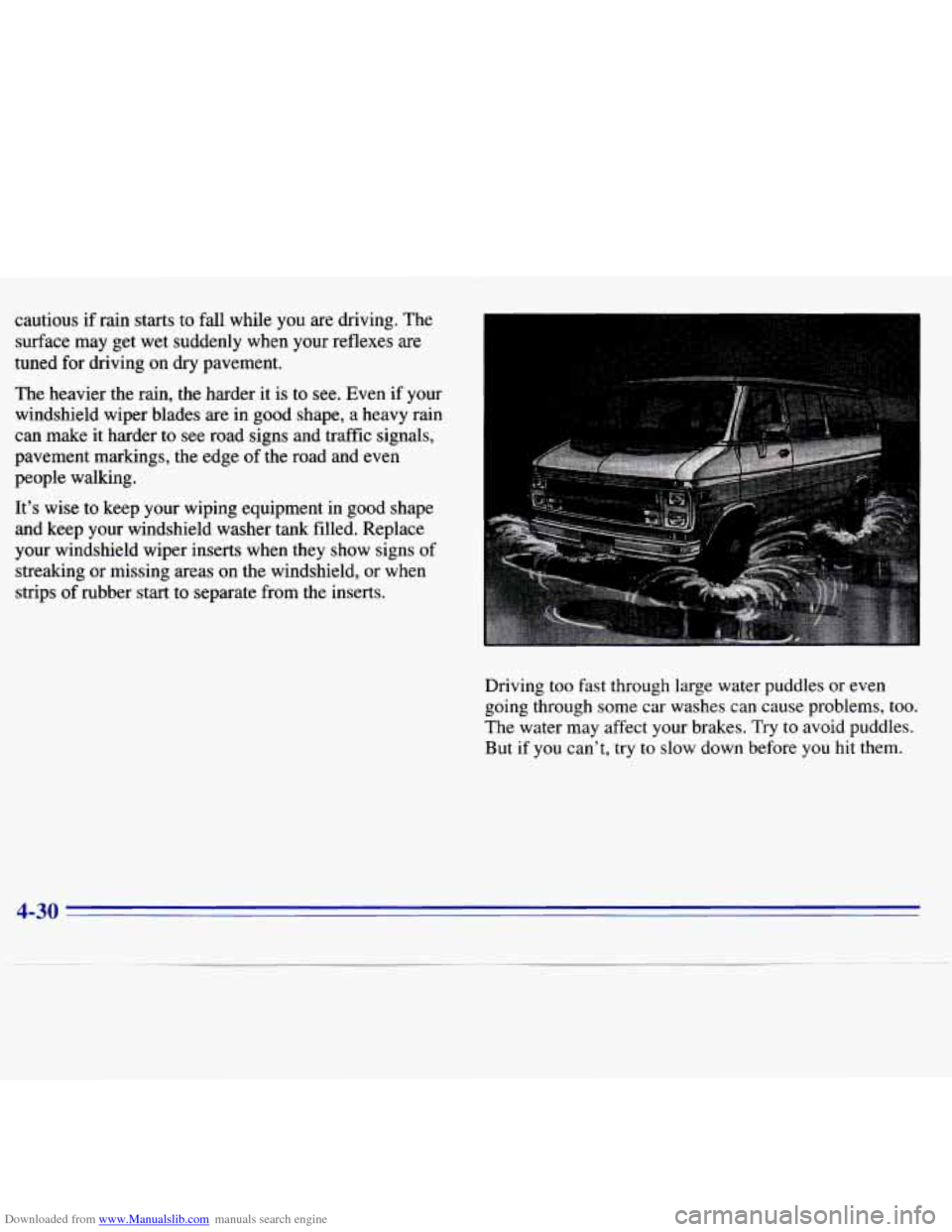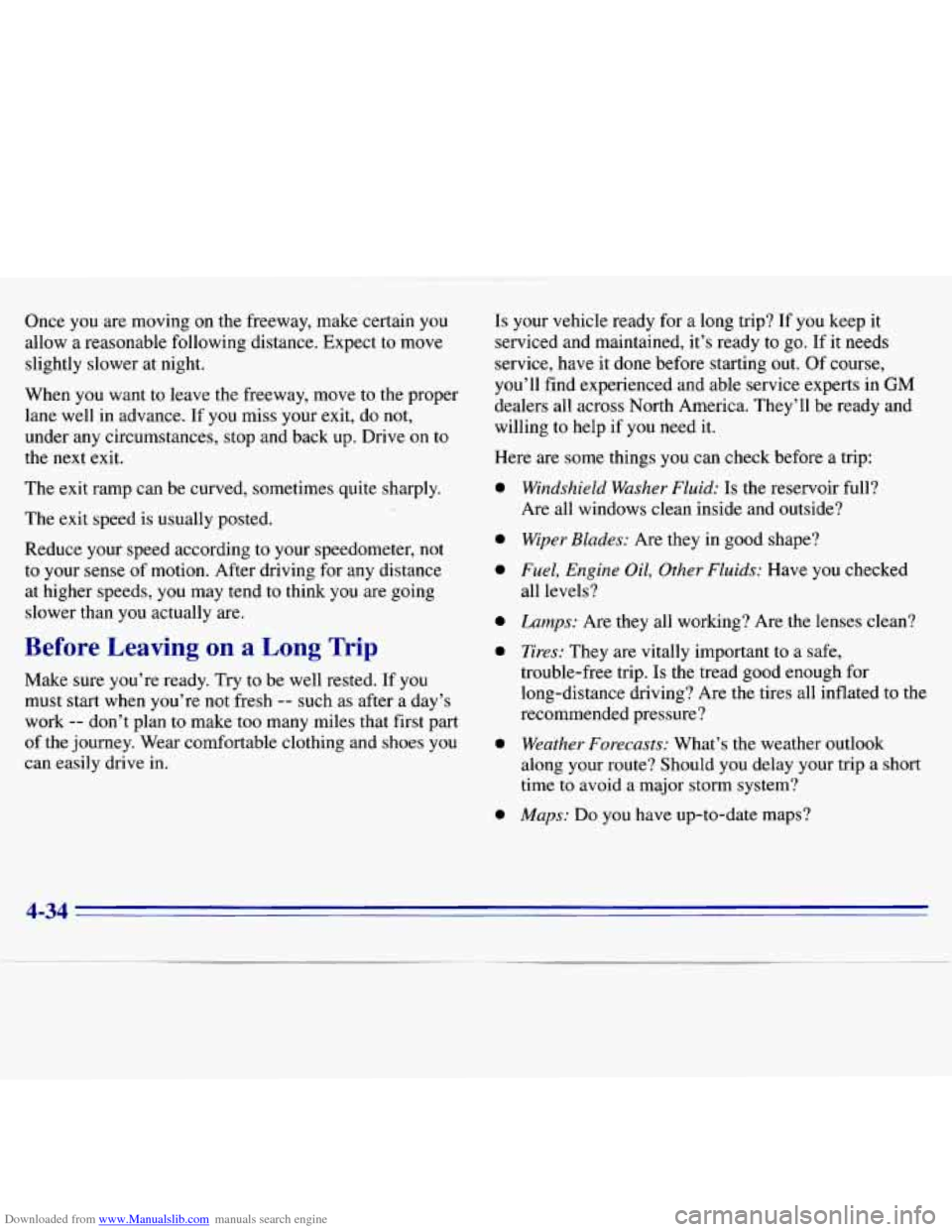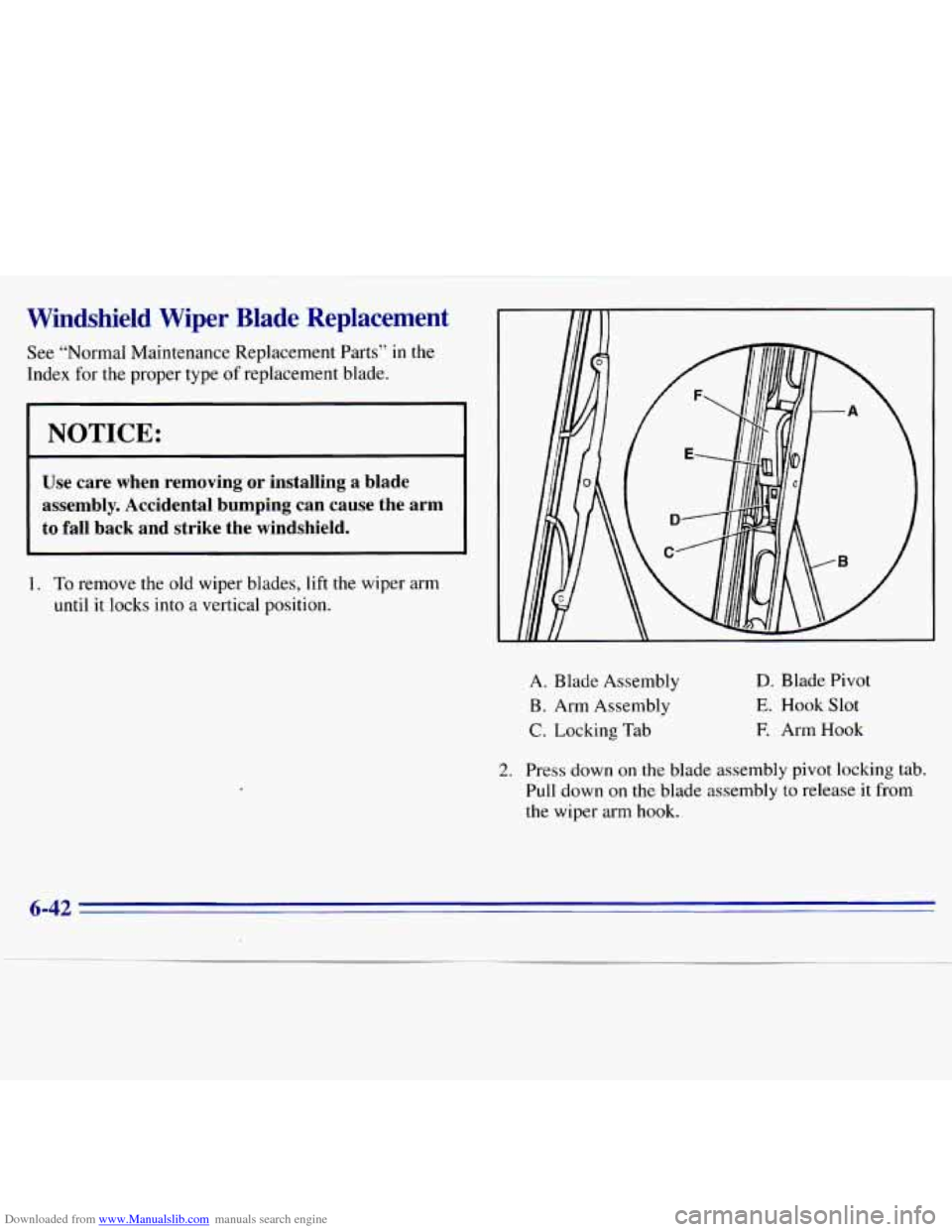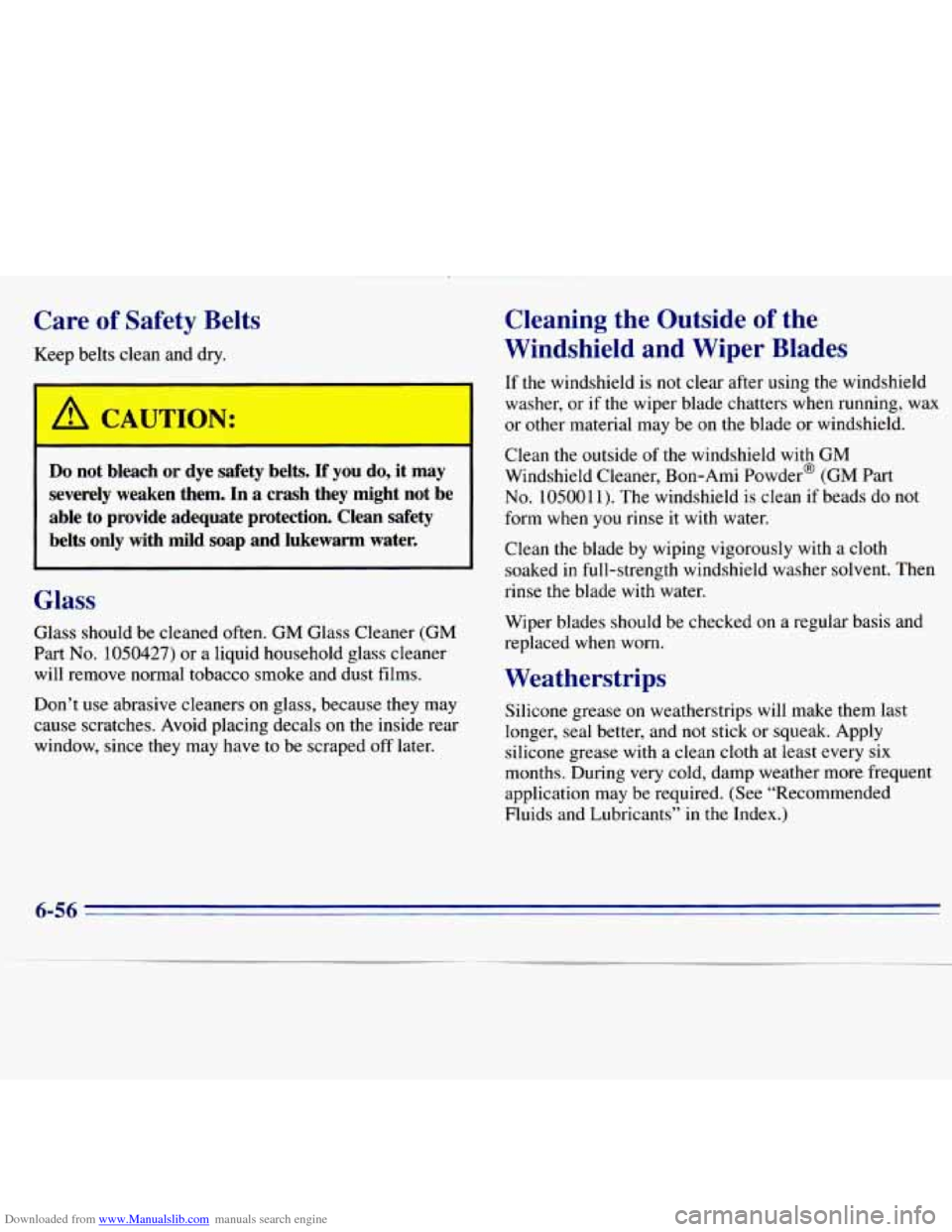1996 CHEVROLET S10 wiper blades
[x] Cancel search: wiper bladesPage 87 of 375

Downloaded from www.Manualslib.com manuals search engine Be sure to clear ice and snow from the wiper blades
before
using them. If they’re frozen to the windshield,
carefully loosen or thaw them.
If your blades do become
worn or damaged, get new blades or blade inserts.
Windshield Washer
At the top of the multifunction lever there’s a paddle
marked with the windshield washer symbol and the
word
PUSH. To spray washer fluid on the windshield,
press the paddle. The wipers will clear the window and
then either stop or return to your preset speed.
Cruise Control (Option)
With cruise control, you can
maintain a speed
of about
25 mph (40 km/h) or more
without keeping your
foot
on the accelerator. This can
really help on long trips.
Cruise control does not
work at speeds below about
25 mph (40 km/h).
-’ C SJTIC -J: If you have an automatic transmission and you apply
-- your brakes, the cruise control will shut off.
In freezing weather, don’t use your washer until If you have a manual transmission and you apply your
the windshield is warmed. Otherwise the washer brakes or push the clutch pedal, the cruise control will
fluid can form ice on the windshield, blocking shut off.
your vision.
2-36
Page 161 of 375

Downloaded from www.Manualslib.com manuals search engine cautious if rain starts to fall while you are driving. The
surface may get wet suddenly when your reflexes are
tuned for driving on dry pavement.
The heavier the rain, the harder it is to see. Even if your
windshield wiper blades are in good shape, a heavy rain
can make it harder to see road signs and traffic signals,
pavement markings, the edge of the road and even
people walking.
It’s wise to keep your wiping equipment in good shape
and keep your windshield washer tank filled. Replace
your windshield wiper inserts when they show signs of
streaking or missing areas on the windshield, or when
strips of rubber start to separate from the inserts.
Driving too fast through large water puddles or even
going through some car washes can cause problems, too.
The water may affect your brakes. Try to avoid puddles.
But
if you can’t, try to slow down before you hit them.
4-30
Page 165 of 375

Downloaded from www.Manualslib.com manuals search engine Once you are moving on the freeway, make certain you
allow
a reasonable following distance. Expect to move
slightly slower
at night.
When you want to leave the freeway, move to the proper
lane well in advance.
If you miss your exit, do not,
under any circumstances, stop and back
up. Drive on to
the
next exit.
The exit ramp can be curved, sometimes quite sharply.
The exit speed is usually posted.
Reduce your speed according to your speedometer, ‘not
to your sense of motion. After driving for
any distance
at higher speeds, you may tend to think you are going
slower than
you actually are.
Before Leaving on a Long Trip
Make sure you’re ready. Try to be well rested. If you
must start when you’re not fresh
-- such as after a day’s
work
-- don’t plan to make too many miles that first part
of the journey. Wear comfortable clothing and shoes you
can easily drive in.
Is your vehicle ready for a long trip? If you keep it
serviced and maintained,
it’s ready to go. If it needs
service, have it done before starting out. Of course,
you’ll find experienced and able service experts in
GM
dealers all across North America. They’ll be ready and
willing to help
if you need it.
Here are some things you can check before
a trip:
0
0
0
0
0
0
0
Windshield Washer Fluid: Is the reservoir full?
Are all windows clean inside and outside?
Wiper Blades: Are they in good shape?
Fuel, Engine Oil, Other Fluids: Have you checked
all levels?
Lamps: Are they all working? Are the lenses clean?
Tires: They are vitally important to a safe,
trouble-free trip.
Is the tread good enough for
long-distance driving? Are the tires all inflated to the
recommended pressure?
Weather Forecasts: What’s the weather outlook
along your route? Should you delay your trip a short
time to avoid a major storm system?
Maps: Do you have up-to-date maps?
4-34
Page 268 of 375

Downloaded from www.Manualslib.com manuals search engine Windshield Wiper Blade Replacement
See “Normal Maintenance Replacement Parts” in the
Index for the proper type
of replacement blade.
NOTICE:
Use care when removing or installing a blade
assembly. Accidental bumping can cause the arm
to fall back and strike the windshield.
1. To remove the old wiper blades, lift the wiper arm
until it locks into a vertical position.
A. Blade Assembly
B. Arm Assembly
C. Locking Tab
D. Blade Pivot
E. Hook Slot
E Arm Hook
2. Press down on the blade assembly pivot locking tab.
Pull down on
the blade assembly to release it from
the wiper arm hook.
6-42
Page 282 of 375

Downloaded from www.Manualslib.com manuals search engine Care of Safety Belts
Keep belts clean and dry.
I A CAUTION:
Do not bleach or dye safety belts. If you do, it may
severely weaken them.
In a crash they might not be
able to provide adequate protection. Clean safety
belts only with mild soap and lukewarm water.
Glass
Glass should be cleaned often. GM Glass Cleaner (GM
Part
No. 1050427) or a liquid household glass cleaner
will remove normal tobacco smoke and dust films.
Don’t use abrasive cleaners on glass, because they may
cause scratches. Avoid placing decals on
the inside rear
window, since they may have
to be scraped off later.
Cleaning the Outside of the
Windshield and Wiper Blades
If the windshield is not clear after using the windshield
washer, or if the wiper blade chatters when running, wax
or other material may be on
the blade or windshield.
Clean the outside
of the windshield with GM
Windshield Cleaner, Bon-Ami Powder@
(GM Part
No. 105001 1). The windshield is clean if beads do not
form when you rinse it with water.
Clean the blade by wiping vigorously with a cloth soaked in full-strength windshield washer solvent. Then
rinse the blade with water.
Wiper blades should be checked on a regular basis and
replaced when worn.
Weatherstrips
Silicone grease on weatherstrips will make them last
longer, seal better, and
not stick or squeak. Apply
silicone grease with a clean cloth at least every six
months. During very cold, damp weather more frequent
application may be required. (See “Recommended
Fluids and Lubricants” in
the Index.)
Page 293 of 375

Downloaded from www.Manualslib.com manuals search engine Normal Maintenance Replacement Parts
Replacement part numbers listed in this section are based on the latest information available at the time of printing,
and are subject
to change. If a part listed in this manual is not the same as the part used in your vehicle when it was
built,
or if you have any questions, please contact your GM truck dealer.
Engine
Thermostat
Oil Filter
Air Cleaner Filter
PCV Valve Automatic Transmission Filter Kit
Spark Plugs
Fuel Filter
Windshield Wiper Blades
2.2L
10 182377
PF47
A1163C
cv9ooc 24200796
4 1-928
GF48 1
Trico (20 inched5
1 cm)
“VORTEC” 4300
1255 1472
PF52
A1 163C
CV746C 24200796
4 1-932
GF48 1
Trico
(20 inched5 1 cm)
6-67
Page 366 of 375

Downloaded from www.Manualslib.com manuals search engine I
Brakes Adjustment ........... ....................... '6-34
qMager Cylinder ............................... 6-31 Anti-Lock .................................... 4-6
Pedal Travel- ................................. 6-34
Replading System Parts ......................... 6-34
Trailer 4-52
Wear ....................................... 6-33
Brake-Transmission' Shift Interlock Check ........... 7-49
Braking ......................................... 4-5
......................................
BTaking in Emergencies ........................... 4-8
Break-In, New Vehicle ............................ 2-8
BTSI Check .................................... 7-49
Bulb Replacement .......................... 6-35., 6-66
Brightness Control ............................. ; 2-42
Canadian Roadside Assistance .................... 8-6
Capacities and Specifications ................. 6-66. 6-68
Cassette Tape Player ......................... 3.7. 3.9
Center High-Mounted Stoplamp Bulb Replacement .... 6-39
Center Passenger Position ........................ 1-25
Certif?cation/Tire Label ............... , ........... 4-42
Chains
Carbon Manoxide .......................... 2.30. 4.40
Care ....................................... 3-18
Safety ...................................... 4-51
Tire ......................................... 6-52 Changing a Flat Tire ............................. 5-22
Charging System Light .......................... 2-54
Check Gages Light ' ' ... ' .. 2-62 ............... ..........
Checking Your Restraint Systems .................... 1-38 Chemical Paint Spotting .......................... 6-59
ChiSd-ReStraints ........................... 1 .... 1-30
Securing in the Center Seat Position (Except W40) . . 1-31
Securing in the Right FTont Seat Position .......... 1-33
Where Not to Put
Top
Strap
................................... : 1-30.
......................... 1-32. 1-33
Cleaner, Air .............................. 6-14, 6-67
Aluminum Wheels ............................ 6-58
Inside of Your Vehicle ......................... 6-53
.
Cigarette Lighter ................................ 2-46
Circuit Breakers and Fuses ......................... 6-63
Cleaning
Fabric
........................................ 6-53
Glass 6-56
Instrument Panel ................ .'. ....... 1 ... 6-55
Leather .................. : ..................... 6-55
Outside of Your Vehicle' ........................ 6-57
Safety Belts ................................... 6-56
Stains ...................................... 6-54
Tires 6-58
.Vinyl ....................................... 6-55
Weatherstrips .................... : ............ 6-56
.......................................
........................................
Wheels ...................................... 6-58
Windshield and Wiper Blades ................... 6-56
Climate Control System ........................... 3-1
Clock, Setting ................................... 3-5
Comfort Controls ................................ 3-1 Clutch, Hydraulic ................................ 6-20
Compact Disc Care ......... I. .................... 3-18
9-2